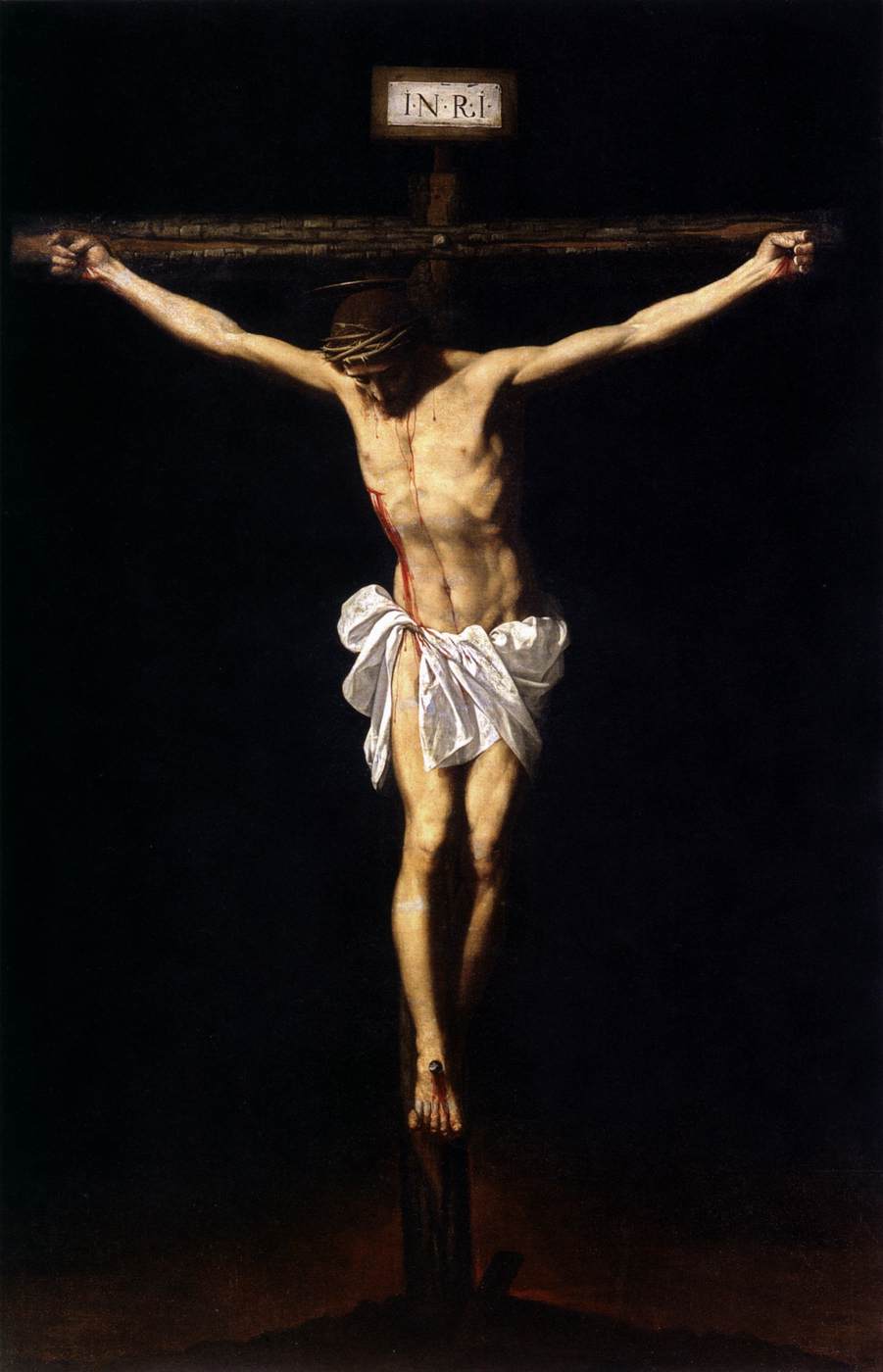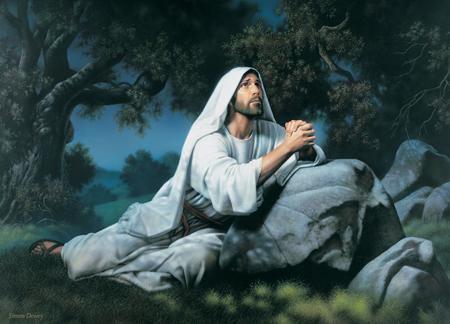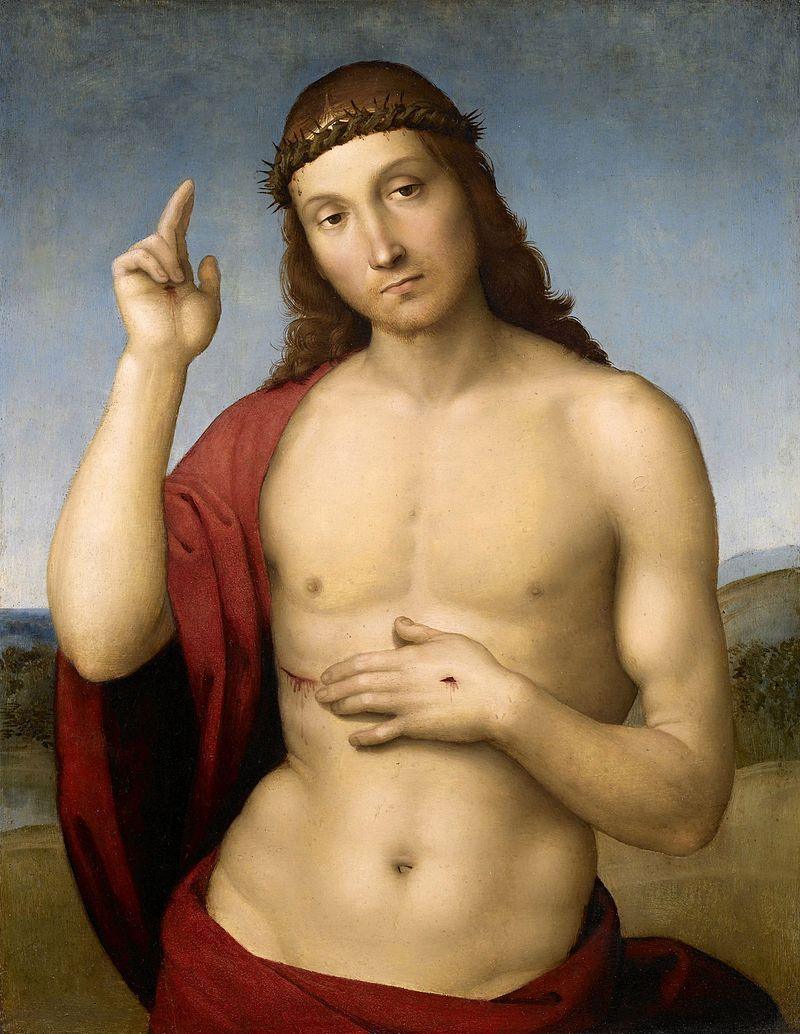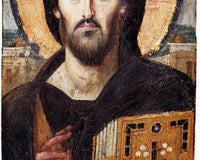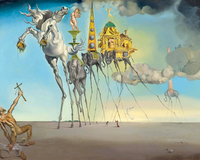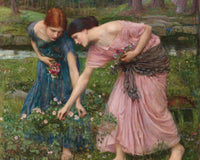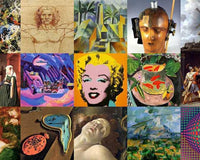The foundations of art history go back tens of thousands of years to when ancient civilizations used available techniques and media to represent a culturally significant subject. Since these early examples, a host of art movements have followed, each with their own distinct styles and characteristics reflecting the political and social influences of the period from which they emerged.
What does fauvism mean and what is conceptual art about? Talking about art seems like a discipline in itself and if you are new to the world of art, you probably have a lot of questions, especially about each movement in art and the different types of art.
Influential art genres, from the Renaissance to the rise of Modernism, have undoubtedly left their mark on history.
By having clear concepts about history and the importance of its artistic movements, we will have a clearer understanding of how famous artists such as Van Gogh, Picasso and Warhol revolutionized the art world.
KUADROS has made for you a list of the most important movements.
No.1 Italian Renaissance (1400–1550)
Some exponents: Doors by Ghiberti, Brunelleschi, Donatello, Botticelli, Leonardo, Michelangelo, Raphael.

Towards the end of the fourteenth century AD. C., a handful of Italian thinkers declared that they lived in a new era. The barbaric, unenlightened "Middle Ages" were over; the new age would be a "rinascità" ("renaissance") of learning and literature, art and culture. This was the birth of the period now known as the Renaissance. For centuries, scholars have agreed that the Italian Renaissance (another word for "renaissance") happened exactly that way: that between the 14th and 17th centuries, a new, modern way of thinking about the world and man's place in it he replaced the old ideas. Indeed, many of the scientific, artistic, and cultural achievements of the so-called Renaissance share common themes, most notably the humanistic belief that man was the center of his own universe.
The Italian Renaissance in Context Fifteenth-century Italy was unlike anywhere else in Europe. It was divided into independent city-states, each with a different form of government. Florence, where the Italian Renaissance began, was an independent republic. It was also a banking and commercial capital and, after London and Constantinople, the third largest city in Europe. Wealthy Florentines flaunted their money and power by becoming patrons or supporters of artists and intellectuals. In this way, the city became the cultural center of Europe and the Renaissance.
It can be said that the Renaissance was divided into two parts:
During the early Renaissance, artists began to reject the Byzantine style of religious painting and strive to create realism in their depiction of human form and space. This drive towards realism began with Cimabue and Giotto, and reached its apogee in the art of "perfect" artists, such as Andrea Mantegna and Paolo Uccello. Although religion was an important element in the daily lives of people who lived during the Renaissance, we also see a new avenue open to panting: the mythological theme. Many scholars point to Botticelli's The Birth of Venus as the first panel painting of a mythological scene.
The period known as the High Renaissance represents the culmination of the aims of the early Renaissance. The best known artists of this phase are Leonardo da Vinci, Raphael, Titian and Michelangelo. His paintings and frescoes are among the best-known works of art in the world. Da Vinci's Last Supper , Raphael 's School Of Athens and Michelangelo's Sistine Chapel ceiling paintings are the masterpieces of this period and embody the elements of the High Renaissance.
Buy a reproduction of The Mona Lisa at the Kuadros online store
No.2 Baroque (1600–1750)
Some exponents: Reubens, Rembrandt, Caravaggio, Velázquez, Palace of Versailles.

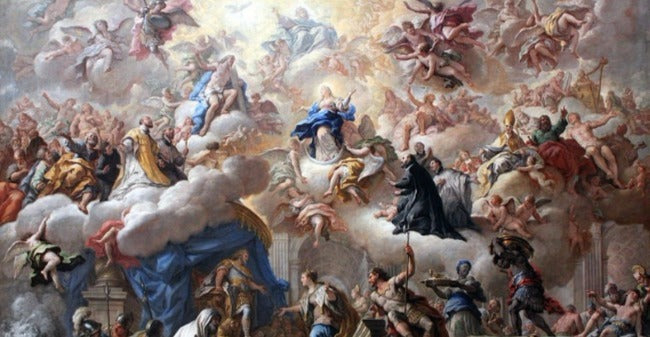
The term baroque probably ultimately derives from the Italian word barocco, which was used by philosophers during the Middle Ages to describe an obstacle in schematic logic. Subsequently, the word came to denote any twisted idea or thought process involved. Another possible source is the Portuguese word baroque (Spanish barrueco), which is used to describe an irregularly or imperfectly shaped pearl, and this usage still survives in the jeweller's term baroque pearl. The Baroque is a movement in art and architecture that developed in Europe from the early 17th century to the mid-18th century. It emphasizes dramatic, exaggerated movement and clear, easy-to-interpret detail, which is a far cry from surrealism, to produce drama, tension, exuberance, and grandeur.
The first manifestations, which occurred in Italy, date from the last decades of the 16th century, while in some regions, notably Germany and colonial South America, certain crowning achievements of the Baroque did not occur until the 18th century.
Artists continued to revive Renaissance ideals of beauty, infusing the period's artwork, music, and architecture with a revived nod to classicism further enhanced by a new exuberant extravagance and penchant for the ornate. This highly ornate style was coined Baroque and was characterized by its innovative techniques and details, offering an exuberant new visual language in what had been a relatively subdued period for the art. The Baroque spread throughout Europe, led primarily by the Pope in Rome and the Catholic rulers in Italy, France, Spain, and Flanders. It was further spread by powerful religious orders through their extensive network of monasteries and convents. The style quickly spread to France, northern Italy, Spain, and Portugal, then to Austria and southern Germany.
The baroque style that developed from this program was, paradoxically, sensual and spiritual; While a naturalistic treatment made the religious image more accessible to the average parishioner, dramatic and illusory effects were used to stimulate piety and devotion and convey an impression of the splendor of the divine. Baroque church ceilings dissolved into painted scenes that presented vivid visions of infinity to the viewer and directed the senses to heavenly concerns.
While subject matter and even style may vary between Baroque paintings, most pieces from this period have one thing in common: drama. In the work of well-known painters such as Caravaggio and Rembrandt , an interest in drama materializes as intense contrasts between radiant light and looming shadows.
That great master of the largely Spanish-ruled Catholic region was the painter Peter Paul Rubens , whose stormy diagonal compositions and sweeping full-blood figures are the epitome of Baroque painting. The elegant portraits of Anthony van Dyck and the robust figurative works of Jacob Jordaens emulated Rubens' example. Art in the Low Countries was conditioned by the realist tastes of its ruling middle-class patrons, and thus both that country's innumerable genre and landscape painters and towering masters like Rembrandt and Frans Hals remained independent of the style. Baroque in important respects. However, the Baroque had a notable impact on England, particularly in the churches and palaces designed, respectively, by Sir Christopher Wren and Sir John Vanbrugh.
Like Renaissance statues, including Michelangelo's iconic David, Baroque sculptures were often intended to adorn stately buildings. They were also commissioned for other grandiose settings, such as gilded church interiors and royal gardens.
The last flowering of the Baroque was largely Roman Catholic in southern Germany and Austria, where native architects broke away from Italian building models in the 1720s.
Buy a reproduction of Las Meninas at the Kuadros online store
No.3 Realism (1848–1900)
Some exponents: Corot, Courbet, Daumier, Millet.

Realism, in the arts, the accurate, detailed, and unadorned representation of nature or contemporary life. Realism rejects imaginative idealization in favor of close observation of outward appearances. As such, realism in its broad sense has encompassed many artistic currents in different civilizations. In the visual arts, for example, realism can be found in ancient Greek Hellenistic sculptures that accurately portray boxers and decrepit old women. The works of 17th century painters such as Caravaggio, the Dutch genre painters, the Spanish painters José de Ribera, Diego Velázquez and Francisco de Zurbarán, and the Le Nain brothers in France are realistic in approach. The works of the 18th-century English novelists Daniel Defoe, Henry Fielding, and Tobias Smollett can also be called realists.
Realism emerged in France in the 1850s. Immediately after the Revolution of 1848, an event that established the "right to work" in the country, the movement introduced the idea of average people, working class, contemporary settings and everyday scenes as worthy artistic subjects.
Realism spread throughout Europe, from the Russia of Alexander II to the Britain of Queen Victoria, from the Germany of William I to the Italy of the Risorgimento, and from the Habsburg Empire to Scandinavia and countries beyond Europe. . The year 1855 was significant in the establishment of realism in Europe.
Gustave Courbet is often considered the leading figure of realism. He laid the foundation for the movement in the 1840s, when he began to portray peasants and workers. The fact that Courbet did not glorify them, but boldly and sternly presented them, created a backlash in the art world.
The style and subject matter of Courbet's work built on ground already broken by the painters of the Barbizon School. Théodore Rousseau, Charles-François Daubigny, Jean-François Millet and others in the early 1830s settled in the French village of Barbizon with the aim of faithfully reproducing the local character of the landscape.
Pictorial realism outside of France was perhaps best represented in the 19th century in the United States. There, Winslow Homer's powerful and expressive paintings of marine themes and Thomas Eakins's portraits, sailing scenes, and other works are frank, unsentimental, and closely observed records of contemporary life. Realism was a distinct current in 20th-century art and generally stemmed from artists' desire to present more candid, candid, and unidealized views of everyday life or from their attempts to use art as a vehicle for criticism. social and political.
The rough, sketchy, almost journalistic scenes of seamed urban life by the group of American painters known as The Eight fall into the former category. The German art movement known as Neue Sachlichkeit (New Objectivity), on the other hand, worked in a realist style to express the cynicism and disillusionment of the post-World War I period in Germany. Socialist realism, officially sponsored in the Soviet Union, used techniques of naturalistic idealization to create portraits of intrepid workers and engineers that were strikingly alike in both their heroic positivism and lack of factual credibility.
Additionally, realism directly inspired important contemporary art movements, such as photorealism and hyperrealism. Building on the remarkably modern approach to realism, these genres demonstrate the enduring and evolving legacy of the groundbreaking movement.
Buy a reproduction of The Gleaners at the Kuadros online store
No.4 Impressionism (1865–1885)
Some exponents: Monet, Manet, Renoir, Pissarro, Cassatt, Morisot, Degas.

French Impressionism is an important movement, first in painting and then in music, which developed mainly in France in the late 19th and early 20th centuries. The most notable feature of Impressionism in painting was an attempt to accurately and objectively record visual reality in terms of transient effects of light and color, Impressionist artists showed a new way of observing and representing the world in their work, giving up to realistic representations of fleeting impressions of their surroundings, which were often outside. In music, it was to convey an idea or effect through a wash of sound rather than a strict formal structure.
By the late 1860s, Manet 's art reflected a new aesthetic, which was to be a guiding force in Impressionist work, in which the importance of traditional subject matter was downgraded and attention shifted to the manipulation of color, tone and texture of the artist. ends in themselves.
In 1874, a group of artists called the Sociedad Anónima de Pintores, Sculptors, Engravers, etc. he organized an exhibition in Paris that launched the movement called Impressionism. Its founding members included Claude Monet, Edgar Degas, and Camille Pissarro, among others. The group performed their first show, independent of the official Salon of the French Academy, which had consistently rejected most of their works. Monet's painting Impression Of The Rising Sun (1872) earned them the initially derisive name "Impressionists" from the journalist Louis Leroy who wrote in the satirical magazine Le Charivari in 1874. Artists soon adopted the name as descriptive of their intention to accurately convey the "visual impressions". While conservative critics criticized his work for its sketchy and sketchy appearance, more progressive writers praised it for its depiction of modern life. Edmond Duranty, for example, in his 1876 essay La Nouvelle Peinture (The New Painting), wrote of his portrayal of contemporary subject matter in a suitably innovative style as a revolution in painting.
Since its inception, Impressionism has been defined by a set of characteristics. These include: painterly brushstrokes, distinctive colors, depictions of common themes, a focus on light, and compositions inspired by photography.
By the mid-1880s, the Impressionist group had begun to dissolve as each painter increasingly pursued his own interests and aesthetic principles. In its short existence, however, it achieved a revolution in art history, providing a technical starting point for Post-Impressionist artists Cézanne , Degas , Paul Gauguin , Vincent van Gogh , and Georges Seurat and freeing all subsequent Western painting from the techniques traditional. and approaches to the subject.
Heritage and presence of Impressionism today
Naturally, as a starting point for modernism, Impressionism influenced many subsequent movements. The Post-Impressionists adopted his painterly brushwork; Abstract Expressionists found inspiration in Monet 's unconventional approach to form; and many contemporary artists even continue to work in a Neo-Impressionist style.
Buy a reproduction of Woman With a Parasol at Kuadros online store
No.5 Post-Impressionism (1885–1910)
Some exponents: Van Gogh, Gauguin, Cézanne, Seurat

Post-Impressionism is a term used to describe the reaction in the 1880s against Impressionism. It was directed by Paul Cézanne, Paul Gauguin, Vincent van Gogh and Georges Seurat. The Post-Impressionists rejected Impressionism's concern with the spontaneous and naturalistic representation of light and colour.
All of these painters except Van Gogh were French, and most of them started out as Impressionists; each of them abandoned the style, to form their own highly personal art.
Like the Impressionists, they emphasized the artificiality of the image. Post-Impressionists also believed that color could be independent of form and composition as an emotional and aesthetic carrier of meaning. Both Impressionism and Post-Impressionism include some of the most famous works of modern art, such as Monet 's Water Lilies, a series of waterscapes, and Van Gogh's The Starry Night .
The Post-Impressionists shared their work with the public through independent exhibitions throughout Paris. In 1910, noted art critic, historian, and curator Roger Fry coined the term "Post-Impressionism" with his show, Manet and the Post-Impressionists. Like the Post-Impressionists themselves, Fry believed that the beauty of art is inherently rooted in perception. "Art is an expression and a stimulus to imaginative life rather than a copy of real life," explains Fry in An Essay in Aesthetics.
As Fry explained, Post-Impressionists believed that a work of art should not revolve around style, process, or aesthetic approach. Instead, it should put an emphasis on symbolism, communicating messages from the artist's subconscious.
The Post-Impressionists often exhibited together, but unlike the Impressionists, who began as a close-knit and cordial group, they mainly painted alone. Cézanne painted in isolation at Aix-en-Provence in the south of France; His solitude was equaled by that of Paul Gauguin, who in 1891 settled in Tahiti, and by Van Gogh, who painted in the countryside at Arles. Both Gauguin and van Gogh rejected the detached objectivity of Impressionism in favor of a more personal spiritual expression.
"Colour! What a deep and mysterious language, the language of dreams. -Paul Gauguin
Unlike the Impressionists who strove to capture the effect of natural light on tonality, the Post-Impressionists purposefully employed an artificial color palette as a way to portray their perceptions of the world around them. Saturated hues, multicolored shades, and rich color ranges are evident in most Post-Impressionist paintings, demonstrating the artists' innovative and imaginative approach to representation.
In general, Post-Impressionism moved away from a naturalistic approach and toward the two main movements in early 20th-century art that replaced it: Cubism and Fauvism, which sought to evoke emotion through color and line.
Buy a reproduction of The Starry Night at the Kuadros online store
No.6 Fauvism and Expressionism (1900–1935)
Paint laid in thick, colors that fly off the page, and unnatural tones – Fauvism and Expressionism are two of the movements that brought these features to life. So what is the difference between them, if they can be described in the same way? First, we will explain Fauvism and Expressionism on their own.
Fauvism
Some exponents: Matisse, Derain, Signac

Fauvism took over the art scene from 1905 to 1910 or so, and is characterized by intense color and bold brushwork. In some cases, artists of this period applied paint directly from the bottle. Colors didn't have to be true to nature, necessarily. They could be changed to show emotion. They chose simple subjects and because of this the paintings seemed almost abstract. Art critic Louis Vauxcelles coined the term after he described the work of Henri Matisse and Andre Derain as "les fauves" or the beasts during a 1905 exhibition at the Salon d'Automne in Paris. The work in the Matisse and Derain exhibition was full of unnaturalistic color choices and wild smears of paint on canvas. It would be the beginning of fauvism.
Fauvist artists were deeply interested in the scientific color theory of the 19th century. Specifically, with the use of complementary colors, the Fauves understood how to make colors appear brighter and bolder by incorporating these theories.
Henri Matisse's painting "Woman with a Hat". It was criticized for the unnatural colors on the woman's face. Paul Signac (1863-1935) is famous for his pointillism. He was also a mentor to Henri Matisse. Pointillism is a technique where small dots of primary colors are placed together. When you zoom out, it merges into a single image. This can be compared to pixels on a computer screen. Each individual pixel is a different color, but when viewed from a slight distance, they create an image. The style of pointillism showed what artists could do with primary colors, and how they could use optical illusions in their work.
In addition to Matisse and Derain, other important Fauvist artists include Georges Braque, Raoul Dufy, Georges Rouault, and Maurice de Vlaminck.
Expressionism
Some exponents: Munch, Carr, Kandinsky, Klee

Expressionism is a general term for any artwork that distorts reality to match the inner feelings, views, or ideas of the artist. In short, it is an art that expresses inner realities in the outer world. This is a fairly general definition, but there are some distinctive features of expressionism. In particular, the colors used in expressionism will be intense and often non-naturalistic, meaning someone's skin could be painted blue instead of tan or brown. Paint is also often used in large amounts in the expressionist style, which creates a lot of texture on the canvas.
Expressionism came "from within", being a reflection of the artist's feelings rather than a representation of a scene. Two influential expressionist artists were Emily Carr and Edvard Munch .
Subject-wise, expressionist art tends to be emotional and sometimes even mythical, assuming that expressionism is an extension of romanticism. Since expressionism is such a broad term, it's easy to start attributing it to art of any era. So, for the most part, expressionism is generally applied to 20th century art. It is said to have started with the work of Vincent van Gogh and extends into modern art as we know it today.
Major contributors to the expressionist movement are artists such as Matisse, Rouault, Oskar Kokoschka, Paul Klee, Max Beckmann, Pablo Picasso, Francis Bacon, Ernst Ludwig Kirchner, Graham Sutherland, Edvard Munch, and others.
Buy a reproduction of The Scream at the Kuadros online store
Fauvism can be seen as a subset of expressionism. Expressionism can include such a wide range of art and movements that it is almost impossible to separate them because they are really different. They use the same techniques and are classified by the same characteristics and the only real difference is the specific nature of Fauvism in contrast to the general nature of Expressionism.
Something that can be considered fauvist could also be part of the field of expressionism. But, something that is considered expressionist is not necessarily in the Fauvist style. Fauvism is a bit wilder, but with a more simplistic theme.
So Fauvism versus Expressionism is not one thing. They are not competing with each other because one is simply a version of the other.
No.7 Cubism (1905–1920)
Some exponents: Pablo Picasso, Georges Braque

Cubism, a highly influential 20th-century visual arts style that was created primarily by artists Pablo Picasso and Georges Braque in Paris between 1907 and 1914. The Cubist style emphasized the flat, two-dimensional surface of the image plane, rejecting traditional techniques. of perspective, foreshortening, modeling and chiaroscuro and refuting the old theories that art should imitate nature. The Cubists believed that the traditions of Western art had been exhausted and to reinvigorate their work, they drew on the expressive energy of the art of other cultures, particularly African art.
Cubism derives its name from comments made by the critic Louis Vauxcelles, who disparagingly described Braque's 1908 work Houses at L'Estaque as being made up of cubes. In Braque's painting, the volumes of the houses, the cylindrical shapes of the trees, and the brown and green color scheme are reminiscent of the landscapes of Paul Cézanne, which deeply inspired the Cubists in their early stage of development (until 1909). However, it was Les Demoiselles d'Avignon, painted by Picasso in 1907, that heralded the new style; In this work, the shapes of five female nudes become angular and fractured forms.
Cubism can be seen to have developed in two distinct phases: the earlier, more austere Analytical Cubism, and a later phase of Cubism known as Synthetic Cubism. Analytical Cubism developed between 1908–12. His artworks look more severe and are made up of a combination of planes and lines in muted shades of blacks, grays and ochres. Synthetic Cubism is the later phase of Cubism, generally considered to date from about 1912 to 1914, and is characterized by simpler shapes and brighter colors. Synthetic Cubist works also often include real elements combined, such as newspapers. The inclusion of real objects directly in art was the beginning of one of the most important ideas in modern art.
While Picasso and Braque are credited with creating this new visual language, it was adopted and developed by many painters, including Fernand Léger, Robert and Sonia Delaunay, Juan Gris, Roger de la Fresnaye, Marcel Duchamp, Albert Gleizes, and Jean Metzinger. Although primarily associated with painting, Cubism also exerted a profound influence on 20th-century sculpture and architecture. The main cubist sculptors were Alexander Archipenko, Raymond Duchamp-Villon and Jacques Lipchitz. Swiss architect Le Corbusier's embrace of Cubist aesthetics is reflected in the forms of the houses he designed during the 1920s.
During the winter of 1912–13 Picasso executed a large number of papiers collés. With this new technique of pasting colored or printed pieces of paper into their compositions, Picasso and Braque swept away the last vestiges of three-dimensional space (illusionism) that still remained in their "high" analytic work.
The liberating formal concepts pioneered by Cubism also had far-reaching consequences for Dada and Surrealism, as well as for all artists pursuing abstraction in Germany, Holland, Italy, England, the United States, and Russia.
No.8 Dada and Surrealism (1917–1950)
Dadaist
Some exponents: Hugo Ball, Marcel Duchamp, Emmy Hennings, Hans Arp, Raoul Hausmann, Hannah Höch, Francis Picabia, George Grosz

Of international scope and diverse artistic production, both Dada and Surrealism were artistic, literary and intellectual movements of the early 20th century that were fundamental in defining modernism. The Dada movement, launched in Zurich in 1916 by poets and artists such as Tristan Tzara and Hans Arp, was a direct reaction to the carnage, propaganda and madness of the First World War. Independent groups linked by common ideas emerged soon after in New York. , Berlin, Paris and other places. These various groups did not share a universal style, but were connected by their rejection of idealism, outdated artistic and intellectual conventions, and modern society's unrestrained embrace of "rationalism" and "progress."
Dada was a European avant-garde art movement, with early centers in Zurich, Switzerland, and New York.
The name, taken from a dictionary in Zurich in 1916, means "rocking horse" in French or "yes yes" in Romanian and Russian. But as the name of a movement it doesn't really mean anything at all. Sick of the culture that had produced the carnage of World War I, Dada defied all the sacred cows, throwing expression and authorship out the window and celebrating chance and absurdity.
Dada's roots lie in the pre-war avant-garde. The term anti-art, a precursor to Dada, was coined by Marcel Duchamp around 1913 to characterize works that defy the accepted restrictions of art.
The Dada movement included public meetings, demonstrations, and publication of art/literary magazines; The passionate coverage of art, politics, and culture were topics often discussed in a variety of media.
The movement influenced later styles such as the avant-garde and centric music movements, and groups including surrealism and pop art.
Surrealism then came along to channel the anti-art energies of Dadaists like Marcel Duchamp back into the museum, sparking a wildly successful but frenetic movement that swept Europe between the wars and embraced many media outlets.
Surrealism
Some exponents: Max Ernst, André Masson, Salvador Dali, René Magritte

One of the most important and subversive movements of the 20th century, Surrealism particularly flourished in the 1920s and 1930s, providing a radical alternative to the rational and formal qualities of Cubism. A literary, philosophical and artistic movement of the 20th century that explored the workings of the mind, defending the irrational, the poetic and the revolutionary.
Unlike Dada, from which it grew in many ways, it emphasized the positive, rather than the pessimistic rejection of earlier traditions.
The word 'surrealist' (which suggests 'beyond reality') was coined by the French avant-garde poet Guillaume Apollinaire in a work written in 1903 and performed in 1917. But it was André Breton, leader of a new group of poets and artists in Paris, who, in his Surrealist Manifesto (1924), defined surrealism as: pure psychic automatism, through which it is proposed to express, whether verbally, in writing or in any other way, the real functioning of thought. Dictated of thought in the absence of any control exercised by reason, outside of all aesthetic and moral concerns.
Several distinct threads can be distinguished in the visual manifestation of surrealism. Artists such as Max Ernst and André Masson favored automatism in which conscious control is removed and the subconscious is allowed to take over. In contrast, Salvador Dalí and René Magritte pursued a hallucinatory sense of superreality in which the scenes depicted make no real sense. A third variation was the juxtaposition of unrelated elements, establishing an unrealizable reality outside the bounds of normal reality. Surrealism originally originated in Paris. His influence spread through a series of international magazines and exhibitions, the most important examples of the latter being the International Surrealist Exhibition at the New Burlington Galleries, London and the Fada of Fantastic Art, Surrealism at the Museum of Modern Art, London. New York, both made in 1936. With the outbreak of World War II, the center of Surrealist activity was transferred to New York and by the end of the War the movement had lost its coherence. However, it has retained a powerful influence, clearly evident in aspects of abstract expressionism and other artistic manifestations of the second half of the 20th century.
Many hold that Surrealism, as an identifiable cultural movement, ended with Breton's death in 1966. Others believe that it remains a vital and relevant force today.
No.9 Abstract Expressionism (1940–1950)
Some exponents: Jackson Pollock, Willem de Kooning, Franz Kline

"Abstract Expressionism" was never an ideal label for the movement, which developed in New York in the 1940s and 1950s. In some ways, it was meant to encompass not just the work of painters who filled their canvases with fields of color and abstract forms, but also those who attacked his canvases with a vigorous gestural expressionism. All were committed to art as expressions of the self, born of deep emotions and universal themes, and most were shaped by the legacy of Surrealism, a movement they translated into a new style that fit the postwar mood of anxiety and trauma. In their success, these New York painters stole Paris's mantle as the leader of modern art and set the stage for America's dominance of the international art world. Abstract Expressionism marked the beginning of New York City's influence as the center of the Western art world. The world of abstract expressionist artists was firmly rooted in Lower Manhattan. A stroll down 8th Street would take you from the Waldorf Cafe, where penniless artists made "tomato soup" with free hot water and ketchup; passed the school of plastic artists Hans Hofmann founded by the painter of the same name; to The Club, a loft where lectures and heated arguments about art continued late into the night. Jackson Pollock's studio was on East 8th Street, Willem de Kooning and Philip Guston were on East 10th, and although Franz Kline moved into various houses and studios in the area, most nights he found him and many of his contemporaries at Cedar Street Tavern at the University Site.
The movement comprised many different painting styles that varied in both technique and quality of expression. They often use degrees of abstraction; that is, they represent unrealistic forms or, in the extreme, forms not drawn from the visible (non-objective) world. They emphasize free, spontaneous, and personal emotional expression, and exercise considerable freedom of technique and execution to achieve this goal, with particular emphasis placed on exploiting the variable physical character of painting to evoke expressive qualities (e.g., sensuality, dynamism). ). , violence, mystery, lyricism).
Most of the artists associated with Abstract Expressionism matured in the 1930s. They were influenced by the leftist politics of the time and came to value art based on personal experience. Few would retain their earlier radical political views, but many continued to take the stance of the Frankish avant-garde.
Despite the diversity of the abstract expressionist movement, three general approaches can be distinguished. One, action painting, is characterized by loose, rapid, dynamic, or energetic handling of paint in sweeping or cutting brushstrokes and in techniques partially dictated by chance, such as dripping or spilling paint directly onto the canvas. Artists: Pollock, De Kooning.
The middle ground within abstract expressionism is represented by several varied styles, ranging from more lyrical, delicate images and flowing forms. Artists: Guston, Frankenthaler, Motherwell, Gottlieb.
The third least emotionally expressive approach was that of Rothko, Newman, and Reinhardt. These painters used large areas, or fields, of flat color and thin, diaphanous paint to achieve quiet, subtle, and almost meditative effects.
Although the movement has been largely depicted throughout historical documentation as belonging to the heroic paint-splattered male artist, there were several important female abstract expressionists who emerged from New York and San Francisco during the 1940s and 1950s who are now receiving credit as elementary members of the canon.
No.10 Pop Art (1960)
Some exponents: Andy Warhol, Roy Lichtenstein, James Rosenquist and Claes Oldenburg
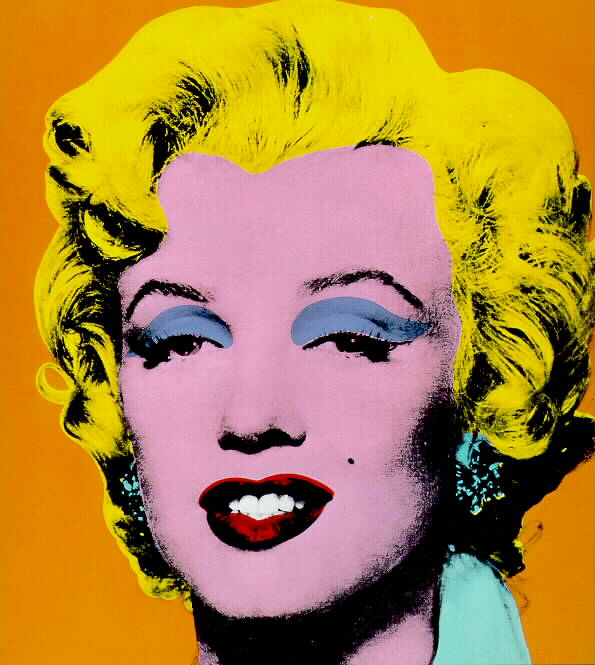
Pop art began with New York artists Andy Warhol, Roy Lichtenstein, James Rosenquist, and Claes Oldenburg, who were inspired by popular images and actually became part of an international phenomenon.
It was a revolt against dominant approaches to art and culture and traditional views on what art should be. Young artists felt that what they were taught in art school and what they saw in museums had nothing to do with their lives or the things they saw around them every day. Instead, they turned to sources like Hollywood movies, advertising, product packaging, pop music, and comics to get their images. Following the popularity of the abstract expressionists, Pop's reintroduction of identifiable imagery (drawn from the media and popular culture) was a major shift in the direction of modernism.
In 1957, Pop artist Richard Hamilton listed the 'characteristics of Pop Art' in a letter to his friends the architects Peter and Alison Smithson: Pop Art is: Popular (designed for a mass audience), Transitory (short-term fix), Expendable (easy to forget), low cost, mass produced, young (aimed at youth), witty, sexy, gimmicky, glamorous, big business. Modernist critics were horrified by Pop artists' use of such 'low' subject matter and by their seemingly uncritical treatment of it. Indeed, pop took art into new subject areas and developed new ways of presenting it in art and can be seen as one of the earliest manifestations of postmodernism.
Although they were inspired by similar themes, British pop is often seen as distinctive of American pop. Early pop art in Britain was driven by American popular culture seen from a distance, while American artists were inspired by what they saw and experienced living within that culture. In the United States, the Pop style was a return to representational art (art that represented the visual world in a recognizable way) and the use of hard edges and distinct forms after the painterly looseness of Abstract Expressionism. By using impersonal and mundane imagery, Pop artists also wanted to move away from the emphasis on personal feelings and personal symbolism that characterized Abstract Expressionism. In Britain, the movement was more academic in its approach. While employing irony and parody, he focused more on what popular American images represented and their power to manipulate people's lifestyles. The 1950s art group The Independent Group (IG) is considered to be the forerunner of the British pop art movement. Pop art was descended from Dada.
Most pop artists aspired to an impersonal and urban attitude in their works. However, some examples of Pop art subtly expressed social criticism, for example Oldenburg's dropped objects and Warhol's monotonous repetitions of the same banal image have an undeniably disturbing effect, and some, like Segal's mysterious and lonely paintings They are openly expressionist.
Perhaps due to the incorporation of commercial imagery, Pop Art has become one of the most recognizable styles of modern art.
No.11 Postmodernism (1970–)
Some exponents: Gerhard Richter, Cindy Sherman, Anselm Kiefer, Frank Gehry, Zaha Hadid

Marilyn in the Sky by © James Gill
That postmodernity is indefinable is a truth. However, it can be described as a set of critical, strategic and rhetorical practices that use concepts such as difference, repetition, trace, simulacrum and hyperreality to destabilize other concepts such as presence, identity, historical progress, certainty. epistemic and univocity of meaning.
The term "postmodernist art" refers to a broad category of contemporary art created from about 1970 onwards. The hallmark of "postmodernist art" is its rejection of the aesthetics on which its predecessor, "modern art" (1870-1970), was based. One of these rejected values is the idea that "art" is something "special" that should be "elevated from" popular taste. Coinciding with a series of new technological developments, Postmodernism has led to almost five decades of artistic experimentation with new media and new art forms, including "Conceptual Art", various types of "Performance Art" and "Installation Art", as well as computer assisted movements such as deconstructivism and projection art. Using these new forms, postmodern artists have broadened the definition of art to the point that "anything goes."
The first important style of art after the Renaissance was academic art, the classical material that was taught by professors in the Academies. Academic art is the artistic equivalent of the traditional "suit and tie." Next, around 1870, comes "modern art". This is the artistic equivalent of the "shirt and pants" or "jacket and pants". Next, around 1970, comes "postmodern art," which is the artistic equivalent of "jeans and T-shirt." In the same way that dress codes have become less formal and more "anything goes," artists today are less impressed with old ideas of what art should be and more focused on creating something (anything) than be noticed.
Anti-authoritarian by nature, postmodernism refused to acknowledge the authority of any style or definition of what art should be. The distinction between high culture and mass or popular culture, between art and everyday life, collapsed. Because postmodernism broke established rules about style, it ushered in a new era of freedom and the feeling that "anything goes." Often funny, ironic, or ridiculous; it can be confrontational and controversial, challenging the limits of taste; but more importantly, it reflects a self-awareness of style itself. Often mixing different artistic and popular styles and media, postmodernist art may also consciously or self-consciously borrow or ironically comment on a variety of styles from the past. Thus, postmodernists see their theoretical position as uniquely inclusive and democratic, as it allows them to recognize the unfair hegemony of Enlightenment discourses over the equally valid perspectives of non-elite groups.
In the 1980s and 1990s, postmodern critiques of contemporary Western society were adopted by academic advocates on behalf of various ethnic, cultural, racial, and religious groups, and postmodernism became the unofficial philosophy of the new "identity politics" movement. ".
KUADROS, a famous painting on your wall.


